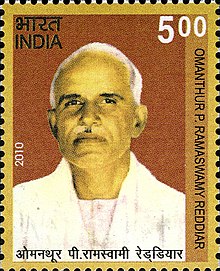O. P. Ramaswamy Reddiyar
Omandur Periyavalavu Ramaswamy Reddiyar | |
|---|---|
 Reddiyar on a 2010 stamp of India | |
| 4th Premier of Madras Presidency | |
| In office 23 March 1947 – 6 April 1949 | |
| Preceded by | Tanguturi Prakasam |
| Succeeded by | P. S. Kumaraswamy Raja |
| Personal details | |
| Born | 1 February 1895 Omandur, Madras Presidency, British India |
| Died | 25 August 1970 (aged 75) Vadalur, Tamil Nadu, India |
| Political party | Indian National Congress |
| Spouse | Singaratha Ammal |
| Occupation | Farmer, Politician |
| Profession | Farmer |
Omandur Periyavalavu Ramasamy Reddiyar (1 February 1895–25 August 1970) was an Indian freedom-fighter and politician of the Indian National Congress. He served as the Premier of Madras Presidency from 23 March 1947 to 6 April 1949.[1][2]
Early life
[edit]Omandur Ramaswamy Reddiyar was born on 1 February 1895 in the village of Omandur near Tindivanam in the South Arcot district of Madras Presidency. He belonged to a Reddiar family. He had his schooling at Walter Scudder school and entered the Indian independence movement at an early age.
Ramaswamy Reddiyar was a devotee of Vallalar.
As chief Minister
[edit]Ramaswamy Reddiyar became the Prime Minister or Premier of Madras on 23 March 1947 and was in power till 6 April 1949. During his tenure, the Madras Temple Entry Authorization Act 1947 was passed.[3] This act was intended to give Dalits and other prohibited Hindus full and complete rights to enter Hindu temples.[3] This was approved by the Governor on 11 May 1947 and passed as Madras Act 5 of 1947.[4] The Devadasi Dedication Abolition Act of 1947 put an end to the devadasi system that was in vogue in many Hindu temples.[5]
It was during his tenure that India achieved independence from the United Kingdom.[6][7] Soon after independence and partition of India, there was a shortage of food grains, especially rice, in the province.[8] In 1948, he ordered the purchase of a de Havilland Dove, the first aeroplane to be owned by the Government of Madras.[2]
In 1948, when the Congress legislative party elections were held, Ramaswamy Reddiyar's candidature was opposed by Tanguturi Prakasam.[9] However, Reddiyar won with the support of K. Kamaraj.[9] However, the Congress leaders were disgruntled with Reddiyar as he did not allow them special privileges.[9][10] So, during the 1949 Congress Legislative Party elections, Kamaraj supported P. S. Kumaraswamy Raja against Ramaswamy Reddiyar.[9][10] Though Ramaswamy Reddiyar was supported by C. Rajagopalachari, P. Subbarayan and T. Prakasam, he lost the vote and stepped down as Prime Minister.[9][10]
| Minister | Portfolio[11] |
|---|---|
| O. P. Ramaswami Reddiyar | Prime Minister, Public, Hindu religious endowments and Harijan uplift |
| M. Bhaktavatsalam | Public works and Planning |
| P. Subbarayan | Home and Legal (Law and Order) |
| T. S. S. Rajan | Food, Motor transport and Labour |
| T. S. Avinashilingam Chettiar | Education |
| Daniel Thomas | Prohibition, Excise, Registration and Housing |
| Vemula Kurmayya | Harijan uplift, Fisheries and Rural development |
| H. Sitarama Reddi | Industries and Information |
| K. Chandramouli | Local administration and Co-operative |
| K. Madhava Menon | Agriculture and Forest |
| Kala Venkata Rao | Revenue |
| A. B. Shetty | Public health |
| S. Gurubatham | Khadi, Firka development and Cottage industries |
- Changes
Subbarayan resigned on 5 April 1948, Daniel Thomas on 15 June 1948 and Kala Venkata Rao on 24 January 1949.
Later years
[edit]When his Premiership of Madras Presidency came to an end in April 1949, Ramaswamy Reddiyar was elected to the Constituent Assembly of India.[12] The complex of buildings that houses the Tamil Nadu Legislative Assembly has been named after him. A commemorative postage stamp on him was released on 25 August 2010.[13]
Works
[edit]- O. P. Ramaswamy Reddiyar (1948). Agrarian reforms and parity economy. Economic Adviser to the Government of Madras.
- O. P. Ramaswamy Reddiyar (1949). Address delivered on the occasion of opening the 19th annual conference on Land Mortgage Banks held on 13th March 1949.
References
[edit]- ^ List of Chief Ministers of Tamil Nadu
- ^ a b S. Muthiah (5 December 2005). "The Government's first plane". The Hindu. Archived from the original on 4 September 2006.
- ^ a b "Right to pray". Frontline. 26 (15). 2009.
- ^ Rāmacandra Kshīrasāgara (1986). Untouchability in India: implementation of the law and abolition. Deep & Deep Publications.
- ^ S. Muthulakshmi Reddy (1964). Autobiography of Mrs. S. Muthulakshmi Reddy. p. 73.
- ^ N. Jayapalan (2001). History Of India : (From National Movement To Present Day), Volume 4 of History of India. Atlantic Publishers and Distributors. p. 70. ISBN 978-81-7156-928-1.
- ^ Constitutional History of India. Atlantic Publishers and Distributors. p. 29.
- ^ Robert Trumbull (21 December 1947). "LACK OF SHELTER IMPERILS INDIANS; Children of Refugees Dying From Pneumonia – Madras Faces Rice Shortage". The New York Times.
- ^ a b c d e P. Kandasamy (2001). The Political Career of K. Kamaraj. Concept Publishing Company. p. 49.
- ^ a b c Forrester, Duncan B. (1970). "Kamaraj: A Study in Percolation of Style". Modern Asian Studies. 4: 43–61. doi:10.1017/S0026749X00010970. S2CID 145472845.
- ^ Justice Party golden jubilee souvenir, 1968. Justice Party. 1968. pp. 50–65. ISBN.
- ^ "List of members of the Constituent Assembly (As in November 1949)".
- ^ "Stamps-2010". Department of Posts, Government of India. Archived from the original on 14 August 2013. Retrieved 2 August 2013.
